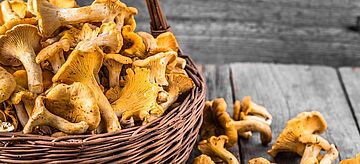Consumer tips on health and food safety

Pursuant to section 13 (5) of the Food and Feed Code, the Federal Environment Ministry has lead responsibility for the prevention of risks to consumers arising from foodstuffs which were exposed to air, soil or water contaminants (known as environmental contaminants).
These contaminants, also called “undesirable substances”, include environmental contaminants such as the heavy metals lead, cadmium and mercury, polychlorinated biphenyls (PCBs), dioxins, other organochlorine compounds and per- and polyfluoroalkyl substances (PFAS). Under German law, only food that is safe may be circulated in Germany. Responsibility for the safety of food lies with the food business operators who produce, transport, store or sell the food. The competent food inspection authorities of the federal states regularly monitor compliance with the relevant legal provisions.
However, not all food that is consumed is subject to official monitoring. This includes food that is not sold commercially, such as fruits and vegetables from household gardens, mushrooms picked in the wild or freshwater fish caught for personal consumption. Nevertheless, consumers can play their own part in reducing individual intake of undesirable substances through food.
A balanced and varied diet is often the best way to minimise the unavoidable intake of undesirable substances through food.
The following consumer tips provide additional guidance for the general public to help individuals reduce their intake of environmental contaminants through food.
Limit consumption of wild mushrooms

The lead, cadmium, mercury and even radionuclide content in wild mushrooms can be much higher than in farmed mushrooms like button mushrooms or other plant-based food.
Regular consumption of wild mushrooms should not exceed 200 to 250 grams per week (based on the wet weight) for adults. Children should eat less depending on their body weight. However, even larger quantities of fresh wild mushrooms do not pose a risk if only consumed occasionally.
Eat fish with low mercury content if pregnant or breastfeeding

Fish is an important source of nutrients and should be an integral part of our diet. Fish can be contaminated with mercury to varying degrees depending on water pollution levels, the age and the species of fish. In general, predatory fish species have higher mercury concentrations than non-predatory species. EU legislation defines maximum levels of mercury for fish and fisheries products. As long as these maximum levels, which are monitored by the food inspection authorities of the federal states, are not exceeded, health risks for the general public with typical eating habits are very unlikely. However, women who are pregnant or breastfeeding as well as their unborn and newborn babies are especially at risk from the toxic effects of mercury.
For this reason, women who are pregnant or breastfeeding are advised to mainly consume fish with comparatively low mercury levels and avoid the following types of fish (and products made from them) on the German market that potentially contain more mercury: shark (also sold as “Schillerlocken”, or strips of smoked dogfish), escolar, eel, spined loach, swordfish, Atlantic and Greenland halibut, pike, monkfish, tuna and Atlantic redfish.
Follow regional advice on freshwater fish caught for personal consumption

Stable compounds such as dioxins and PCBs have been accumulating in riverbeds for many years. As a result, wild fish in rivers can still ingest considerable amounts of harmful dioxins and PCBs through the food chain. This is why freshwater fish still contain high levels of contaminants even though significantly fewer dioxins and PCBs are discharged into the environment today than in the past.
Dioxins and PCBs accumulate in the fatty tissue of fish as they are especially persistent and highly soluble in fat. Eels are very fatty fish. Levels above the maximum set by law for dioxins and PCBs are relatively common in freshwater fish. Freshwater fish also tend to exhibit higher concentrations of per- and polyfluoroalkyl substances (PFAS). Levels can vary quite a bit regionally.
Anglers (and their families) should check the contamination level of fish in the respective river sections with the competent federal state authorities. A number of Länder provide relevant guidance on their websites.
What to be aware of if you eat offal

Offal from wild game
In contrast to the offal of many farmed animals, which show decreasing levels of heavy metal contamination, offal from wild game, such as rabbit, deer and wild boar, may be significantly contaminated with heavy metals and also with dioxins, polychlorinated biphenyls (PCBs) and per- and polyfluoroalkyl substances (PFAS). As a general rule, the offal of any wild animal should only be consumed occasionally, for example no more than every two to three weeks.
Use caution with wild boar liver
Wild boar liver frequently has very high concentrations of per- and polyfluoroalkyl substances (PFAS). The Federal Institute for Risk Assessment (BfR) says that these levels overwhelmingly exceed the PFAS maximum level allowed in the EU for offal from wild game. PFAS have a long half-life in the human body. This means that eating a125-gram portion of wild boar liver with an average PFAS concentration once per year is enough to exceed the human tolerance threshold of these harmful substances in the long term.
The Federal Environment Ministry advises against consuming wild boar liver, regardless of the age of the animal it comes from. In particular, children, women of childbearing age and pregnant or breastfeeding women should not eat wild boar liver or products made from it such as liverwurst or pâté made from game.
Wild boar meat generally does not exhibit similarly high PFAS concentrations. Hunters should check with the competent state authority for information about potential locally increased PFAS levels in wild boars. A number of Länder provide guidance on their websites.
Sheep liver
The term sheep liver refers to liver from lambs and adult ewes and rams. The Federal Institute for Risk Assessment (BfR) has received measurements from the federal state monitoring programmes for the years 2016 and 2022. The levels of dioxins and PCBs are high in most of the samples. In some cases they exceed the maximum levels applicable in the EU.
Because of the high level of background contamination with dioxins and PCBs, the BfR recommends avoiding the consumption of sheep liver as a precaution.
Canned cod liver in oil
Studies have shown that canned cod liver in oil often contains high levels of dioxins and PCBs. In early July 2008, an EU-wide maximum level (limit value) of 25 picograms per gram wet weight in total was introduced for the sum of dioxins and dioxin-like PCBs in fish liver and fish liver products. This maximum level was replaced in January 2012 with a limit value of 20 picogram per gram wet weight, also in total, for dioxins and dioxin-like PCBs. However, even this lower maximum level does not ensure consumer health protection in cases of regular consumption of cod liver in oil. Regular consumption may lead to exceeding the maximum tolerable intake for dioxins and dioxin-like PCBs.
As a health precaution, consuming cod liver in oil (usual portion size of 150 g) should be limited to once every two months at most.
